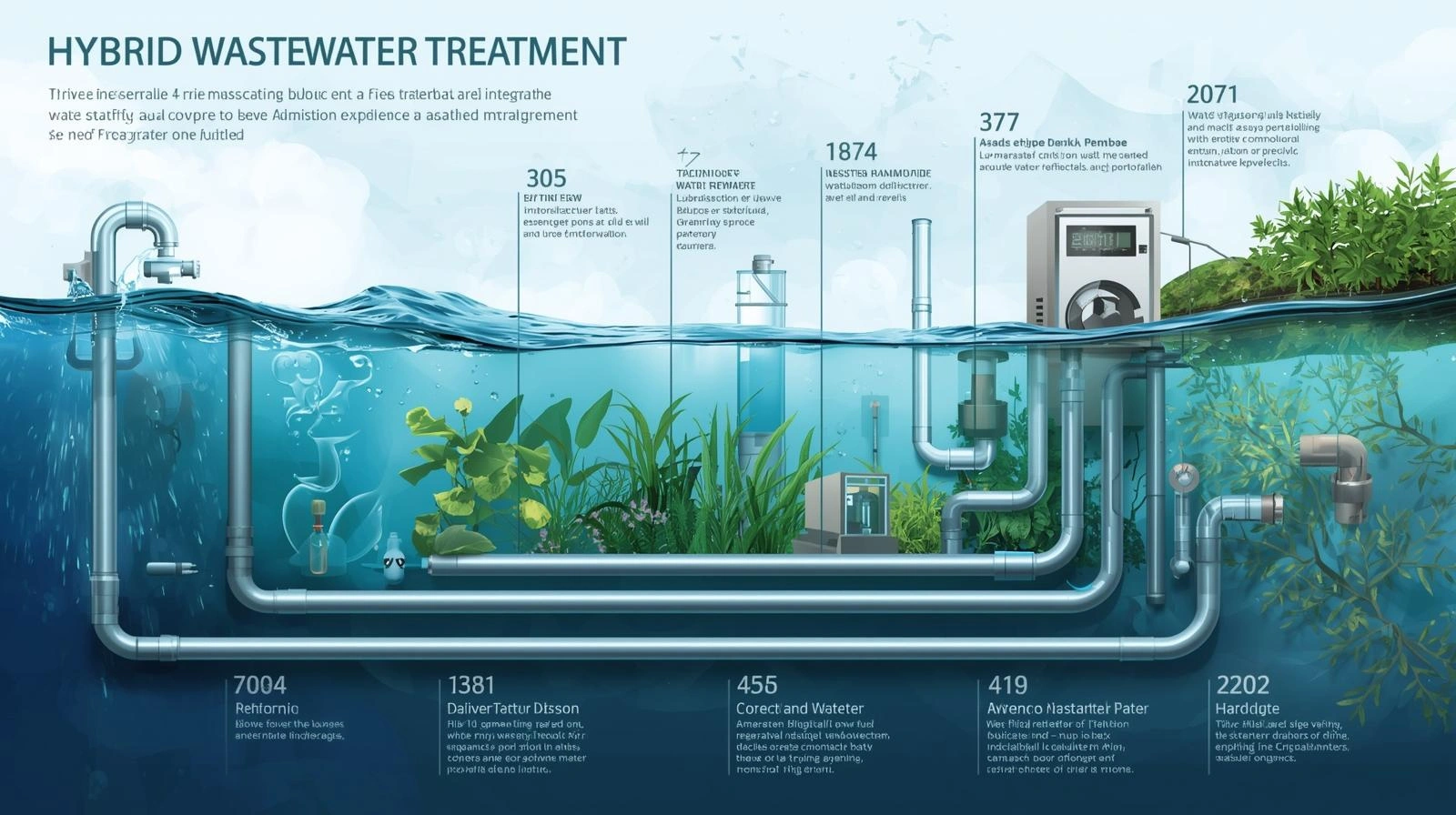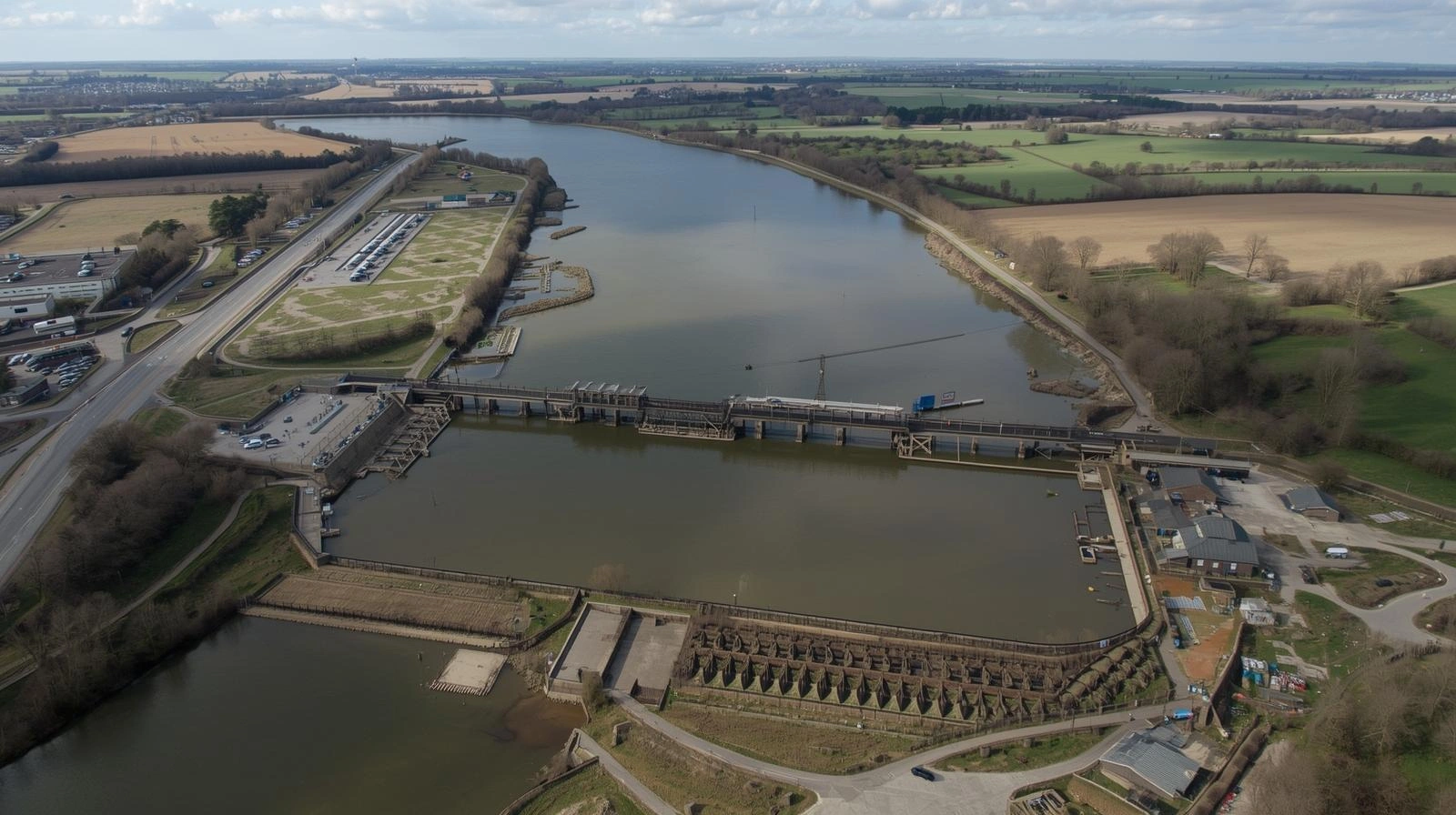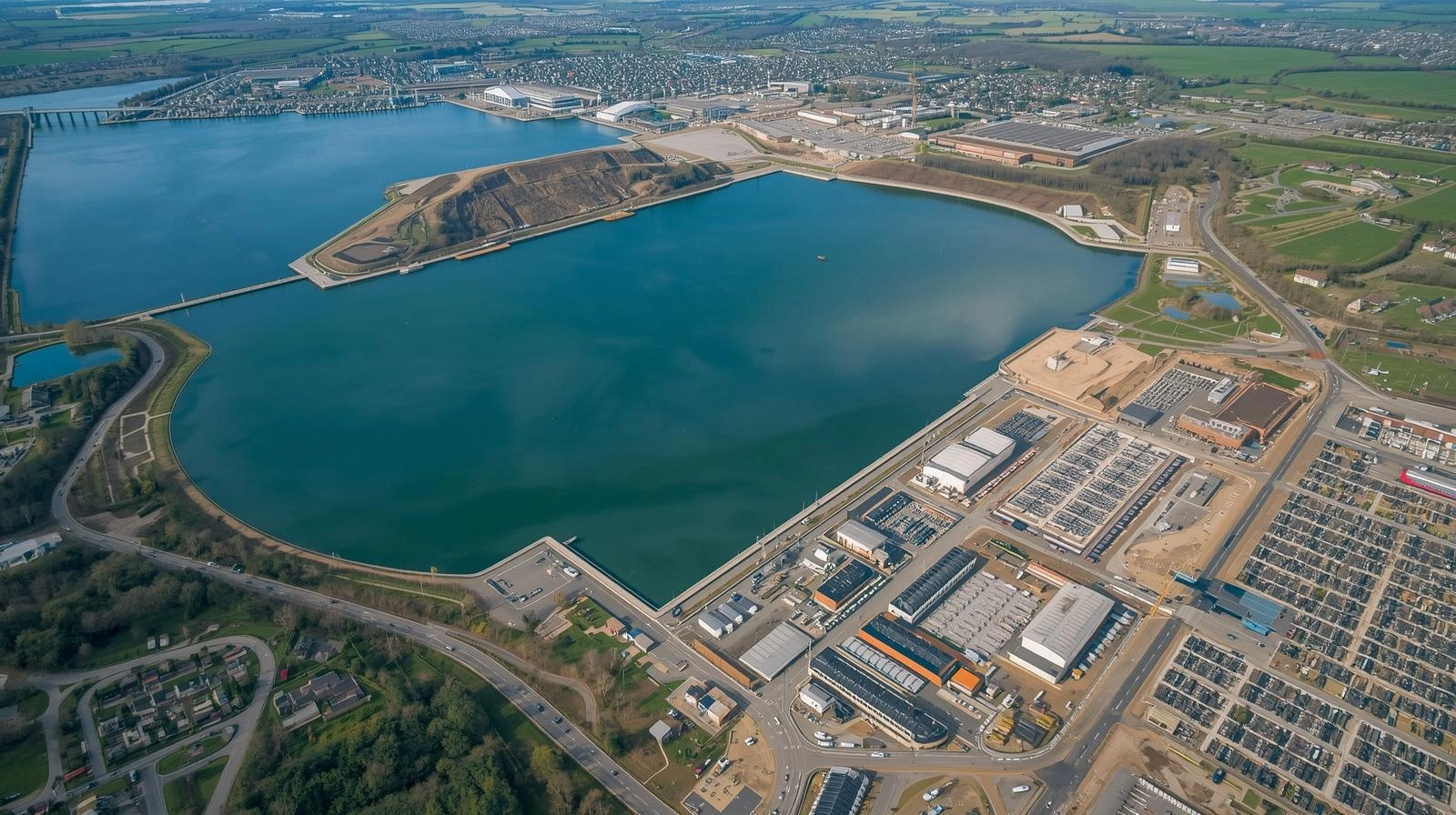What if wastewater treatment could be both highly efficient and eco-friendly? With growing environmental concerns and the demand for smarter resource management, finding innovative solutions to wastewater management is crucial. One promising approach is the hybrid treatment system—a combination of natural processes and cutting-edge technology designed to optimize wastewater treatment while minimizing environmental impact.
In this blog, we’ll explore how hybrid wastewater systems are transforming the landscape of water management by blending biological treatment processes with advanced technologies, leading to more sustainable and efficient solutions. From wastewater treatment innovations to integrated water management, hybrid systems are paving the way for a greener future in wastewater treatment.
What Are Hybrid Wastewater Systems?
Hybrid wastewater systems are designed to integrate the best of both natural and technological processes in wastewater treatment. These systems typically combine biological treatment methods, such as constructed wetlands and bioreactors, with advanced mechanical processes like membrane filtration, UV disinfection, or chemical treatments.
The idea behind a hybrid system is to leverage the strengths of both approaches: the eco-friendly and low-maintenance nature of biological treatment and the high efficiency and precision of technological methods. The goal is to create a comprehensive system that not only treats wastewater effectively but does so in a way that minimizes energy consumption, operational costs, and environmental impact.
How Do Biological Treatment Methods Enhance Hybrid Wastewater Systems?
Biological treatment is one of the core components of hybrid wastewater systems, playing a key role in breaking down organic pollutants and improving water quality. This process relies on microorganisms, such as bacteria, fungi, and algae, to decompose organic matter and nutrients in wastewater, transforming harmful substances into less toxic byproducts.
In hybrid systems, biological treatment methods are often combined with more advanced technologies to improve the efficiency and speed of treatment. For instance, constructed wetlands and biological filtration beds can be used as the initial stage of treatment, where microorganisms remove organic material. Following this, advanced technologies like membrane filtration or UV disinfection can be applied for final polishing, ensuring that the water is safe and clean before it is released into the environment or reused.
The synergy between biological treatment and technology makes hybrid systems a highly efficient and versatile option for wastewater treatment, capable of handling varying levels of pollution and offering greater flexibility than traditional systems.
Water Main Replacement Planned After 80 Years of Service
Free Annual Water Quality Testing Encouraged for Private Water Supply Owners
Public Consultation on Thames Water’s Abingdon Reservoir Sparks Mixed Reactions
Water’s New Mega Reservoir Project Near Abingdon Draws Public Attention
Islanders Urged to Cut Shower Time as Water Reserves Continue to Decline
Water Companies Ordered to Return £260 Million to Customers Over Poor Performance
CMA Redetermines UK Water Price Controls, Cutting Company Requests by 80%
European Commission opens cases against Estonia & Austria over Drinking Water Directive
Why Are Hybrid Systems Considered Wastewater Treatment Innovations?
Hybrid wastewater systems are seen as a significant innovation in the industry due to their ability to combine the best of traditional, natural methods with state-of-the-art technological solutions. Unlike conventional wastewater treatment systems that rely on either biological or technological approaches alone, hybrid systems provide a more integrated and adaptable solution.
Some of the key innovations in hybrid systems include:
- Energy Efficiency: Hybrid systems are designed to minimize energy consumption by combining low-energy biological processes with high-performance technological methods. For example, natural filtration systems require little to no energy input compared to energy-intensive mechanical treatments, while advanced technologies are used to boost efficiency when necessary.
- Water Reuse and Recycling: Hybrid systems are excellent for facilitating water reuse. By combining biological processes with membrane filtration or reverse osmosis, treated water can be reused for non-potable purposes like irrigation, industrial cooling, or even recreational purposes. This makes hybrid systems an integral part of integrated water management strategies.
- Customization: One of the innovations of hybrid systems is their flexibility. These systems can be tailored to meet specific treatment requirements, whether in urban or rural settings. By combining different biological and technological treatment processes, hybrid systems can effectively address a wide range of wastewater conditions, from municipal wastewater to industrial effluent.
- Reduced Chemical Usage: Hybrid systems can reduce the reliance on chemicals, especially when natural biological treatments play a significant role. This makes the treatment process more eco-friendly, as fewer chemicals are required for disinfection or coagulation.
How Do Hybrid Wastewater Systems Contribute to Integrated Water Management?
Integrated water management (IWM) is an approach that focuses on managing water resources in a coordinated and sustainable way. It involves the holistic management of water systems, considering the needs of various stakeholders, including environmental, social, and economic factors.
Hybrid wastewater systems contribute significantly to IWM by offering a sustainable and flexible solution to wastewater treatment. They allow for more efficient use of water resources by treating wastewater and making it available for reuse. This helps reduce the demand for freshwater, especially in water-scarce regions. Additionally, hybrid systems can be integrated into existing water infrastructure, providing an adaptive solution that meets the evolving needs of communities.
By utilizing both natural and technological treatment processes, hybrid systems offer a comprehensive approach to wastewater management that supports broader sustainability goals. They can play a pivotal role in ensuring that treated water is available for various uses, contributing to water conservation and reducing the environmental footprint of wastewater treatment plants.
What Are the Benefits of Eco-Friendly Water Treatment with Hybrid Systems?
The shift toward more sustainable and eco-friendly water treatment methods has become a critical focus in the wastewater management industry. Hybrid systems are at the forefront of this movement, offering several environmental benefits:
- Low Carbon Footprint: Since hybrid systems rely heavily on biological processes that require minimal energy, they have a significantly lower carbon footprint compared to conventional, energy-intensive wastewater treatment methods. This helps mitigate climate change and promotes a more sustainable future for water management.
- Reduced Pollution: By combining biological treatments with advanced filtration and disinfection technologies, hybrid systems ensure that harmful pollutants are removed from wastewater before it is returned to the environment. This helps protect ecosystems and prevents contamination of freshwater sources.
- Minimal Chemical Use: Eco-friendly hybrid systems reduce the need for chemical treatments, which can be harmful to the environment if overused. Biological processes are naturally designed to break down pollutants, and when combined with technologies like UV disinfection, they can provide effective treatment without the need for harsh chemicals.
- Waste Reduction: Hybrid systems often generate less waste compared to traditional methods. For example, constructed wetlands, a common biological treatment method, require less sludge disposal, reducing the environmental impact associated with sludge management.
- Sustainable Resource Use: Hybrid wastewater systems are designed to optimize the use of available resources. By reusing treated water for irrigation or industrial purposes, these systems contribute to more sustainable water use, reducing reliance on freshwater sources and promoting water conservation.
How Are Hybrid Wastewater Systems Implemented in Different Settings?
Hybrid wastewater systems can be adapted to suit a variety of settings, from large municipal treatment plants to small, decentralized systems in rural or remote areas. The versatility of hybrid systems allows them to be used in different applications, including:
- Municipal Wastewater Treatment: In urban areas, hybrid systems can be integrated into existing infrastructure to improve the efficiency of wastewater treatment plants. The combination of biological processes and advanced technologies enables municipalities to meet stricter environmental regulations while reducing costs.
- Industrial Wastewater Treatment: Many industries, such as food processing, pharmaceuticals, and textiles, produce wastewater with high levels of contaminants. Hybrid systems offer an effective and eco-friendly solution to treat industrial effluent, reducing the need for chemical treatments and ensuring that water is safe for reuse.
- Rural and Decentralized Wastewater Treatment: Hybrid systems are particularly beneficial in rural or off-grid areas where access to advanced infrastructure may be limited. Decentralized hybrid treatment systems can be set up in these areas, providing a cost-effective and sustainable solution for managing wastewater.
FAQs about Hybrid Wastewater Systems
- What is a hybrid wastewater system?
A hybrid wastewater system combines natural biological treatment methods, like constructed wetlands, with advanced technological treatments, such as membrane filtration and UV disinfection. This integration improves treatment efficiency, reduces energy consumption, and promotes sustainability.
- What are the advantages of using hybrid systems for wastewater treatment?
Hybrid systems offer several advantages, including improved efficiency, lower energy consumption, reduced chemical usage, and increased flexibility. They also contribute to sustainable water management by enabling water reuse and reducing environmental impact.
- How do biological treatment methods work in hybrid systems?
Biological treatment in hybrid systems relies on microorganisms to break down organic pollutants and nutrients in wastewater. These natural processes are often used as the first stage of treatment, with advanced technologies used for final polishing to ensure high-quality treated water.
- Can hybrid wastewater systems be used for industrial wastewater?
Yes, hybrid wastewater systems are highly effective for treating industrial wastewater. They can be customized to handle high levels of contaminants typically found in industrial effluent, offering an eco-friendly and cost-effective solution.
- How do hybrid systems contribute to integrated water management?
Hybrid systems support integrated water management by providing sustainable wastewater treatment that allows for water reuse and conservation. By reducing the demand for freshwater and optimizing wastewater treatment, hybrid systems contribute to more efficient and sustainable water resource management.
Conclusion
Hybrid wastewater systems are revolutionizing the way we approach water treatment, combining the best of natural processes and technological innovations to provide efficient, sustainable, and eco-friendly solutions. By integrating biological treatment methods with advanced technologies, hybrid systems offer a versatile and cost-effective way to manage wastewater across different settings, from municipalities to industries to rural areas.
As the demand for smarter, more sustainable water management solutions grows, hybrid systems will continue to play an essential role in meeting these challenges. With their ability to reduce energy consumption, minimize waste, and promote water reuse, hybrid systems are a key player in the future of wastewater treatment and integrated water management.
FAQs About Real-Time Monitoring in Wastewater Treatment
1. What is real-time wastewater monitoring?
Real-time wastewater monitoring involves continuously measuring and analyzing water quality parameters at various stages of the treatment process to ensure that the water meets quality standards.
2. How does AI improve water quality in wastewater treatment?
AI improves water quality by analyzing real-time data from sensors, predicting potential issues, and making adjustments to optimize treatment processes, leading to faster and more efficient wastewater treatment.
3. What are the benefits of AI in wastewater treatment?
AI benefits include enhanced water quality, operational efficiency, predictive maintenance, faster response times to contamination, and ensuring compliance with environmental regulations.
4. What is smart water treatment?
Smart water treatment refers to the use of AI, machine learning, and sensor technology to automate, optimize, and monitor wastewater treatment processes for improved efficiency and performance.
5. What are the challenges of implementing real-time monitoring systems?
Challenges include high initial setup costs, data integration, training staff, and ensuring cybersecurity for the systems.









